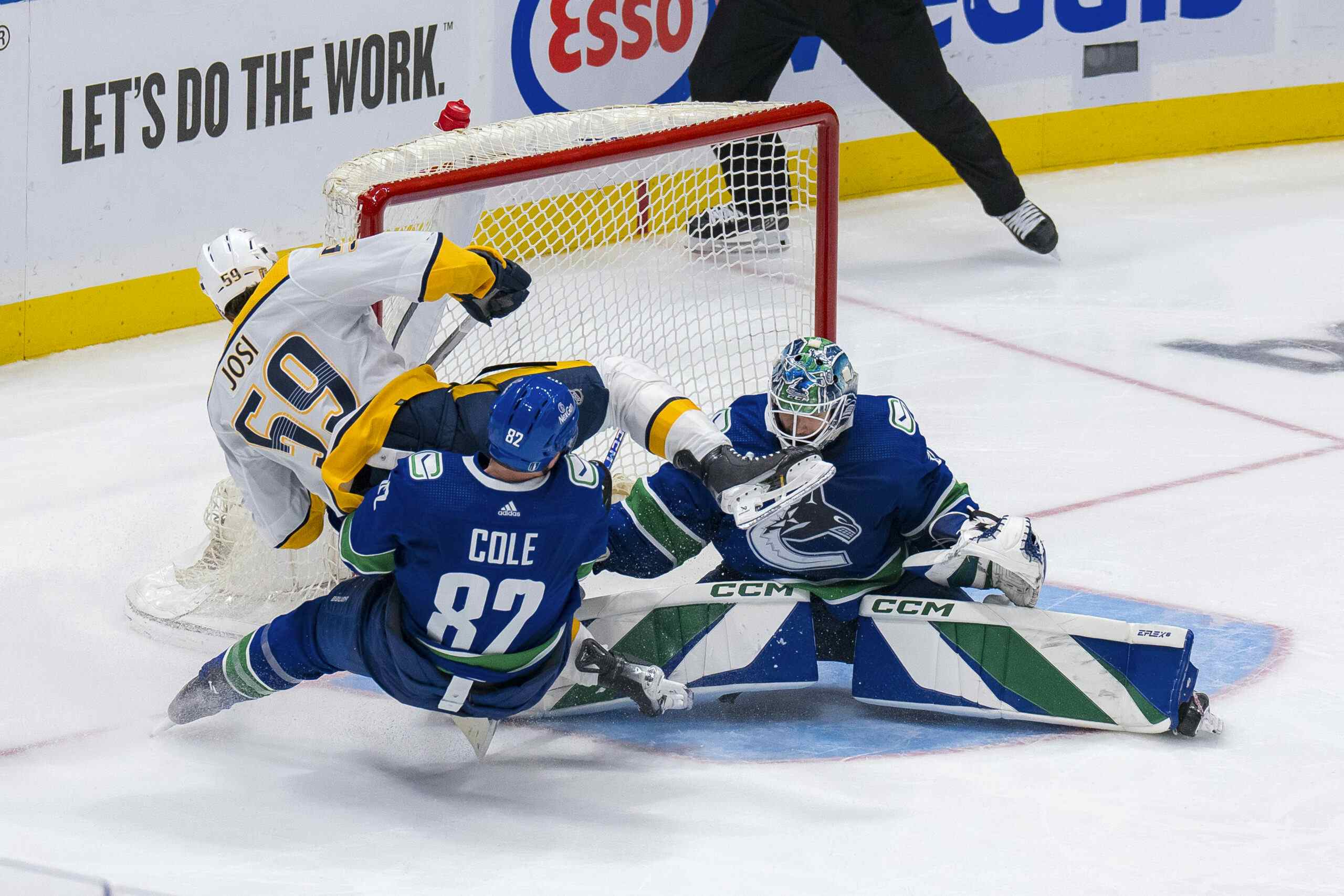Thom Drance and I at Canucks Army, along with many other hockey analysts, like to use numbers like “Corsi” and “Fenwick”, which measure on-ice player shot differentials throughout the season. But critics of simple shot indicators like to say that these numbers don’t matter because they don’t take into account the quality of a shot.
So Thom and I seeked to reconcile this by sitting in front of the TV and watching every minute of every game, sober even, and recording every single quality shot. A web application helps us find out who was on the ice for every single scoring chance.
We’re given a sheet at the end of every game, we post it here, and then we count them up. In the absence of much else better to do today, I figure we’d share our data with the world.
Here are the definitions:
Corsi: All shot attempts, including saved shots, missed shots and blocked shots. This can be expressed as either a differential (where 0 is even) or a rate (where 50% is even).
Fenwick: Like Corsi, but blocked shots are removed.
Scoring chance: An unblocked shot attempt (dribblers excluded) from within the “home plate” area of the offensive zone. The home plate area is defined as the area between the faceoff dots, extending to the “Bowman line” at the top of the offensive zone circles.
Now, many (or some) readers will remember that
I have already posted raw scoring chance totals. Using those raw numbers, we can also compare players via time-on-ice. I took every player’s even strength time on ice total and calculated their scoring chance rate per 60 minutes:
| # | Skater | TOI | EVF | EVA | CF/60 | CA/60 | CD/60 |
| 8 | Chris Tanev | 393.3 | 120 | 91 | 18.3 | 13.9 | 4.4 |
| 7 | David Booth | 743.1 | 235 | 188 | 19.0 | 15.2 | 3.8 |
| 26.1 | Mikael Samuelsson | 66.3 | 17 | 13 | 15.4 | 11.8 | 3.6 |
| 20 | Chris Higgins | 952.5 | 295 | 239 | 18.6 | 15.1 | 3.5 |
| 33 | Henrik Sedin | 1257 | 365 | 301 | 17.4 | 14.4 | 3.1 |
| 22 | Daniel Sedin | 1096.8 | 310 | 256 | 17.0 | 14.0 | 3.0 |
| 17 | Ryan Kesler | 1123.9 | 327 | 281 | 17.5 | 15.0 | 2.5 |
| 15 | Marco Sturm | 61 | 16 | 14 | 15.7 | 13.8 | 2.0 |
| 4 | Keith Ballard | 675.8 | 169 | 149 | 15.0 | 13.2 | 1.8 |
| 21 | Mason Raymond | 744.7 | 210 | 188 | 16.9 | 15.1 | 1.8 |
| 14 | Alex Burrows | 1155.9 | 319 | 285 | 16.6 | 14.8 | 1.8 |
| 2 | Dan Hamhuis | 1528 | 410 | 370 | 16.1 | 14.5 | 1.6 |
| 9.1 | Cody Hodgson | 686.2 | 163 | 156 | 14.3 | 13.6 | 0.6 |
| 3 | Kevin Bieksa | 1506.9 | 395 | 400 | 15.7 | 15.9 | -0.2 |
| 29 | Aaron Rome | 602.1 | 161 | 164 | 16.0 | 16.3 | -0.3 |
| 25 | Andrew Ebbett | 152.2 | 34 | 35 | 13.4 | 13.8 | -0.4 |
| 36 | Jannik Hansen | 1033.9 | 256 | 263 | 14.9 | 15.3 | -0.4 |
| 23 | Alex Edler | 1488.8 | 361 | 378 | 14.5 | 15.2 | -0.7 |
| 6 | Sami Salo | 1060.4 | 258 | 275 | 14.6 | 15.6 | -1.0 |
| 5 | Marc-André Gragnani | 193.7 | 52 | 56 | 16.1 | 17.3 | -1.2 |
| 79 | Mike Duco | 48.2 | 10 | 11 | 12.4 | 13.7 | -1.2 |
| 41 | Andrew Alberts | 575.4 | 120 | 141 | 12.5 | 14.7 | -2.2 |
| 52 | Alexander Sulzer | 180.9 | 37 | 45 | 12.3 | 14.9 | -2.7 |
| 26.2 | Samuel Pahlsson | 236.6 | 57 | 68 | 14.5 | 17.2 | -2.8 |
| 54 | Aaron Volpatti | 203.9 | 32 | 46 | 9.4 | 13.5 | -4.1 |
| 9.2 | Zack Kassian | 174.7 | 45 | 58 | 15.5 | 19.9 | -4.5 |
| 40 | Maxim Lapierre | 821.4 | 151 | 213 | 11.0 | 15.6 | -4.5 |
| 34 | Byron Bitz | 104.3 | 19 | 27 | 10.9 | 15.5 | -4.6 |
| 24 | Mark Mancari | 49.9 | 6 | 10 | 7.2 | 12.0 | -4.8 |
| 32 | Dale Wiese | 549 | 77 | 129 | 8.4 | 14.1 | -5.7 |
| 27 | Manny Malhotra | 769 | 120 | 205 | 9.4 | 16.0 | -6.6 |
| 42 | Bill Sweatt | 10.2 | 0 | 3 | 0.0 | 17.6 | -17.6 |
| 38 | Victor Oreskovich | 5.9 | 0 | 4 | 0.0 | 40.7 | -40.7 |
Oh, hey, look who’s right up at the top…
With Chris Tanev on the ice, the Canucks would get a little over 18 scoring chances per hour and concede a little under 14. That’s the biggest differential on the team. David Booth, a man who supposedly suppresses his teammates’ shooting percentage, also ranks highly. 55.6% of all chances when Booth was on the ice were in Vancouver’s favour, but unfortunately, just 50% of all goals. He’s still very snakebitten, but brings the puck to the right areas.
Note Cody Hodgson. Much better than Zack Kassian. That is how Zack Kassian will forever be judged, unfortunately.
Adjusting for zone starts, now. I only took the players who played 200 or more minutes:
| # | Skater | CD/60 | EDS/60 | Adj/60 |
| 8 | Chris Tanev | 4.4 | 5.9 | 5.1 |
| 20 | Chris Higgins | 3.5 | 2.0 | 3.7 |
| 7 | David Booth | 3.8 | -6.4 | 3.1 |
| 17 | Ryan Kesler | 2.5 | 1.1 | 2.6 |
| 4 | Keith Ballard | 1.8 | 2.9 | 2.1 |
| 2 | Dan Hamhuis | 1.6 | 2.2 | 1.8 |
| 21 | Mason Raymond | 1.8 | -6.5 | 1.1 |
| 33 | Henrik Sedin | 3.1 | -23.2 | 0.5 |
| 9.1 | Cody Hodgson | 0.6 | -1.3 | 0.5 |
| 22 | Daniel Sedin | 3.0 | -22.6 | 0.5 |
| 36 | Jannik Hansen | -0.4 | 6.0 | 0.3 |
| 29 | Aaron Rome | -0.3 | 4.5 | 0.2 |
| 3 | Kevin Bieksa | -0.2 | 1.0 | -0.1 |
| 14 | Alex Burrows | 1.8 | -19.8 | -0.4 |
| 26.2 | Samuel Pahlsson | -2.8 | 18.3 | -0.8 |
| 41 | Andrew Alberts | -2.2 | 7.0 | -1.4 |
| 23 | Alex Edler | -0.7 | -7.5 | -1.5 |
| 6 | Sami Salo | -1.0 | -6.5 | -1.7 |
| 27 | Manny Malhotra | -6.6 | 44.7 | -1.7 |
| 40 | Maxim Lapierre | -4.5 | 23.4 | -1.9 |
| 54 | Aaron Volpatti | -4.1 | 13.2 | -2.7 |
| 32 | Dale Wiese | -5.7 | 18.6 | -3.6 |
CD/60 – Chance differential per 60 minutes
EDS/60 – Defensive zone starts minus offensive zone starts per 60 minutes
Adj/60 – Adjusted scoring chance differential. The Chris Tanev Index.
So the question that all this begs is what do all these numbers mean? Specifically, what do your adjusted totals tell us about specific players. When I read those numbers, and a variety of alarm bells go off about your analysis.
First of all, let’s just outline what the Sedins have done specifically over the last couple of years: combine for two league scoring titles, win a Ted Lindsay and a Hart trophy, and guide the franchise to two consecutive Presdident’s Trophies and a Western Conference Championship. In other words, they are elite talents. This fact is undeniable.
However, the adjusted Corsi and Fenwick totals do not indicate this at all. In fact, based on these adjusted reports, your numbers would predict more success for Malhotra, Mancari, Sturm, etc. than they would for Henrik and Daniel if O-zone start% was more or less equal. To me, this says one of two things: either Corsi and Fenwick are completely useless at indicating anything resembling success and should be ignored entirely, or the method of standardization is critically flawed in that it skews cases of “specialized deployments” too much one way or another. This second conclusion is particularly significant in this case because we know that Alain Vigneault radicalizes player deployment to a greater extent than any other coach in the NHL.
Now, I’m familiar enough with the concepts of possession to know that they are not completely useless, and in fact they are a pretty decent indicator of something (although my own research into team Corsi% and Fenwick% vs. actual team success has yielded only weak correlations at best), so I’m much more comfortable concluding that there is a problem with these particular adjustments to individual Corsi and Fenwick numbers. Granted, I haven’t looked in to adjusting for zone starts enough to suggest a more accurate standardization, however I can say with a fair degree of confidence that the numbers you have simply do not make sense in the context of what we know about these players.
Therefore, I would either seek a different method of adjusting Corsi and Fenwick for zone starts, or I would disregard the adjusted numbers entirely.
Good point. Either we look at these numbers and theorize that Aaron Volpatti is a better player than Henrik and Daniel Sedin, or what we were doing in the first place was wrong. I halved my original scoring chance adjustment (counting an extra offensive zone start as -.11 of a chance as opposed to -.22) and the results fit more with reality.
I remain convinced that Henrik and Daniel are poor defensive players. Because Alain Vigneault deploys them so dramatically in the offensive zone, we don’t know to what effect just yet. I am also quite convinced that the American trio of forwards are the three best two-way players on the Canucks, and that Chris Tanev is very effective when playing limited, optimized minutes against third line competition. Wonder how soon until he takes the next step.
Oh, and onto the whole “shot quality” thing? Check out the correlation between a player’s scoring chance rate and his Corsi, Fenwick, and goal rate:
Fenwick:
R-squared = .81931
Corsi:
R-squared = .80548
Goals:
R-squared = .40754
Fenwick and Corsi are much better than goals at predicting a player’s scoring chance differential. Fenwick is therefore then probably better at predicting a team’s total goals rate. This is why we disregard shot quality in many instances: it doesn’t predict the actual amount of goals a team will get.
Some players perform marginally better by Fenwick standards than scoring chances. Those players are Keith Ballard (53.1% chances, 49.4% Fenwick) and Mason Raymond (52.8% chances, 49.4% Fenwick). The two players who performed the worse by this measure among regulars were Samme Pahlsson (45.6% chances, 50.3% Fenwick) and Kevin Bieksa (49.7% chances, 53.4% Fenwick).









